Week’s work can be reached by the numbered buttons at the bottom of the page.
Week 1: Tues. Jan. 12
What are some of the strategies Katchadourin, Dyment and Park used to select and order books in their final works? What were their decisions based on? How do the final compositions expand the meaning of each individual book, or come together to have a new and surprising meaning about the library, the family, about language and books, or about anything else?
Nina Katchdourin:
- Katchdourin’s work deals with personal archives and libraries.
- decisions are based on what sounds good or what may be useful for representing the owner of the archive.
- They use a clipboard to formulate an inventory of all the books, making note of book titles that stand out. the titles are then transcribes on to index cards that are moved around and rearranged in poem-like compositions. This stage is to decide what titles work together. A final stage of this process is using the the actually books to sculpt the poem.
- Katchdourin’s work extends the meaning of the collection to be a portrait the owner.
Dave Dyment:
- Dyment’s work and decisions are based around isolated text, or questions, from an archive.
- Their practice is centered around research.
- He says that he is interested in culture, and how it’s made and changes over time. For instance, One Billon Years (Past and Future), reorganizing a collection of history books in a chronological order.
Ryan Park:
- Park’s decision on Untitled are based on colour and the spine of books.
- All books are stack on each others spine allowing the pages to be facing upward. This decision makes reading the titles and text harder, giving the impression that is not the focus of this project.
- all books are hardcover
- Larger, wider books are used to single out book’s colour which is close to pure, or represent a kind of local colour. This is exactly what expands the meaning of the collection, by focusing on the physical qualities of the books, their context is lost. They become more of a colourful sculpture. They might even represent a kind of spectrum of topics, or Queer texts (seeing that a rainbow can be linked to LGBTQ ).
Select two pieces to discuss.
I would like to focus primarily on the works of Dave Dyment’s 2012 project, One Billion Years [Past and Future] (Left) and Ryan Park‘s Untitled (2009; Right). At a glance, the two of them share a common material to work with, that being books, and the similarities end there.
Dyment’s work is based on isolating texts, or questions, from an archive. These “Pull quotes” help Dyment to create a representative of the cultures that he likes to explore. Park’s book stack does not do this, instead it leans more into the sculptural quality of books, neglecting text of each of them. Which makes me think that the spines are ignored but actually Park has found another use for them other than displaying. In Untitled, Park uses the spine of hardcover books to support the stack and their aesthetic quality spatial quality to organize them. Larger, wider books are used to single out book’s colour which is close to pure, or represent a kind of local colour. This is exactly what expands the meaning of the collection, by focusing on the physical qualities of the books, their context is lost. They become more of a colourful sculpture. They might even represent a kind of spectrum of topics, or Queer texts (seeing that a rainbow can be linked to LGBTQ ).
Notes:

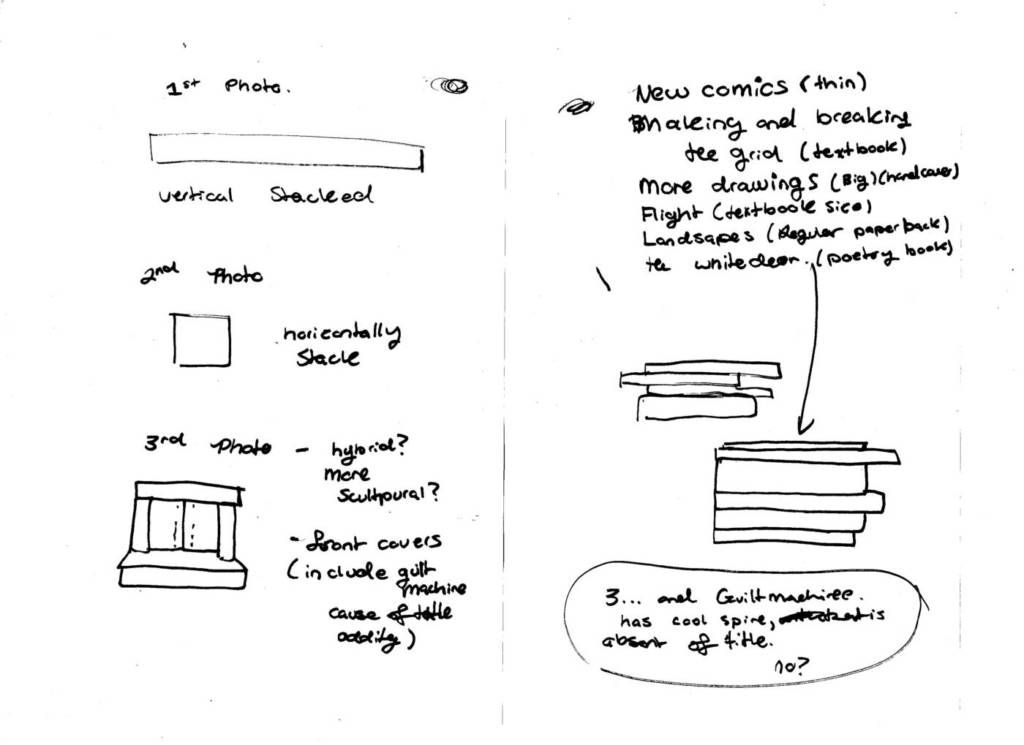
Three Sorted books:
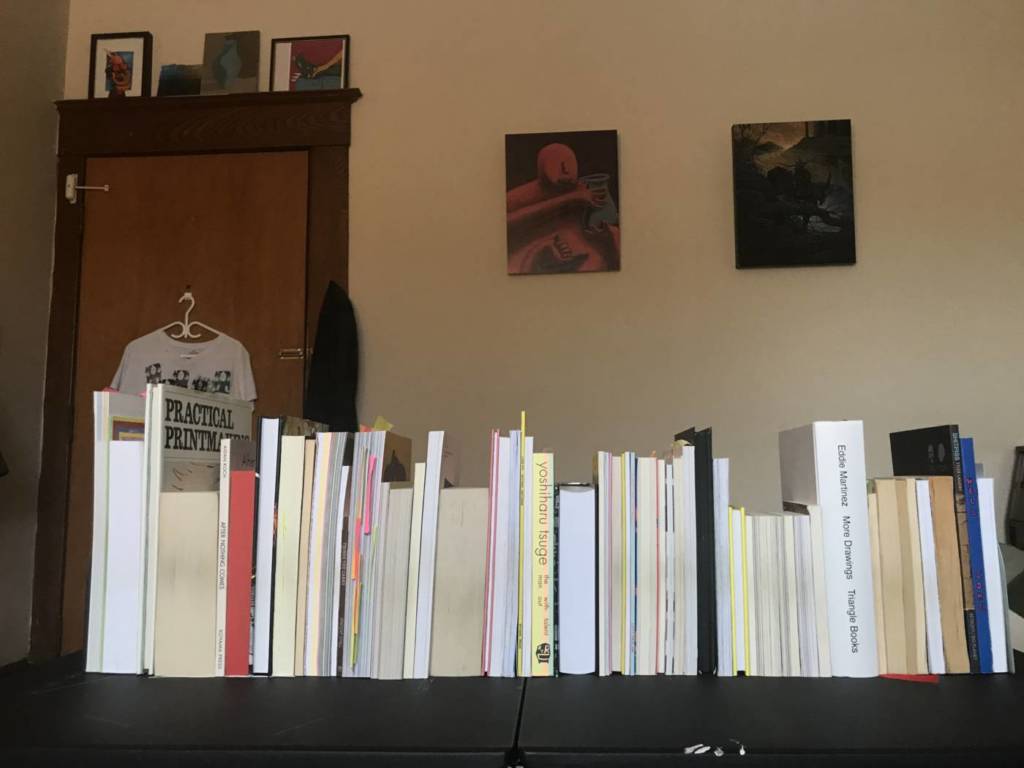
Well Come
Shit and Piss
More Drawings
The Man Without Talent
Lose
Things You Carry
After Nothing Comes
For most of these I carried on with Katchdourin’s method of planning to the stack of books. This is one instance that came from writing down a couple lists of my library, at least, titles that seemed interesting. The titles in that make up this Stack-poem create this kind of self-deprecating humour about myself? I primary spend my spare time drawing, and I am mostly self taught, So I make a lot of rough and unfocused material.
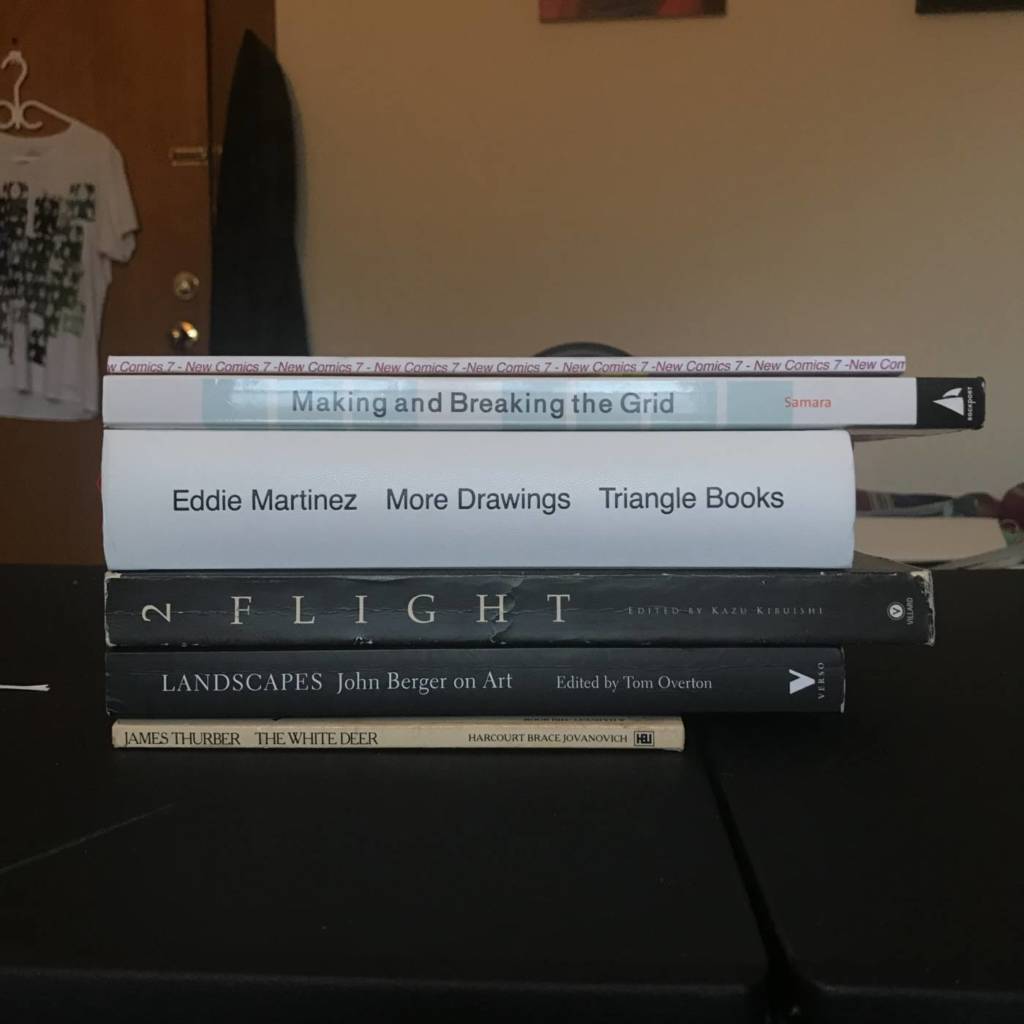
New Comics
Making and Breaking the Grid
More Drawings
Flight
Landscapes
The White Deer
This one goes continues this activity of drawing but brings in ideas of structure and subjects, actions and places. I want this to have a gestalt feeling too.
They are stack on the side to reinforce the poem aspect of the titles, but I don’t exactly go all the way by lining the titles. Instead, I line the book themselves, in which was my way of acknowledging the material -I did not want to lose the idea that they are books organized and creating a signal shape. more than likely, I didn’t want to lose the straight edge that the books make when they are flushed left, as if there’s a presence pushing against them.
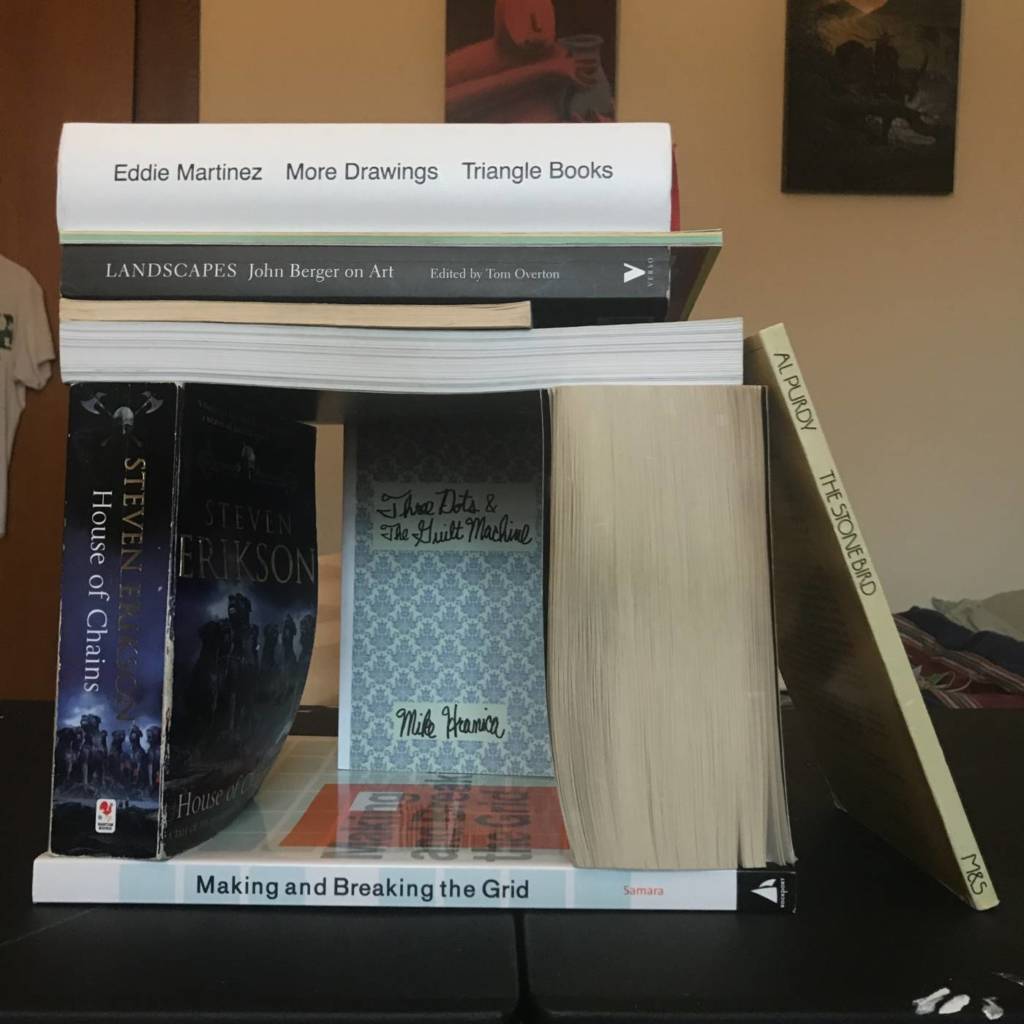
More Drawings
Landscapes
House of Chains
Three Dots & the Guilt Machine
The Stone Bird
Making and Breaking the Grid
For this final stack, I hadn’t the chance to make use of the title Three Dots & the Guilt Machine because of how it was designed ( No title on spine.) To me the title interesting for multiple meanings. For me, it is ironic because it’s title is specific and not at the same time. So, for me to allow this title to be part of the stack exercise I needed it to face forward. To do this, I thought of the books in a more sculptural sense then I would had with the previous two. It started with the base layer, making use of the design textbook about grids as a pun, then I would use these thick fantasy books as support, or columns, to make a second level that more stacked books could be added. Within this structure it allowed for that the Guilt Machine to enter the sculpture.
Again, I kept to the idea of drawing, revolving around places and things and structures.
These are all important books to me. More often than not, they reflect my interests and aspirations, which should not to be confused with what they display, but, I guess, what they accomplish and express. I think there is something admirable to these books that were chosen. It is ironic then that I would make stack-poems to poke fun at myself, and maybe because I hold the books to a high standard.
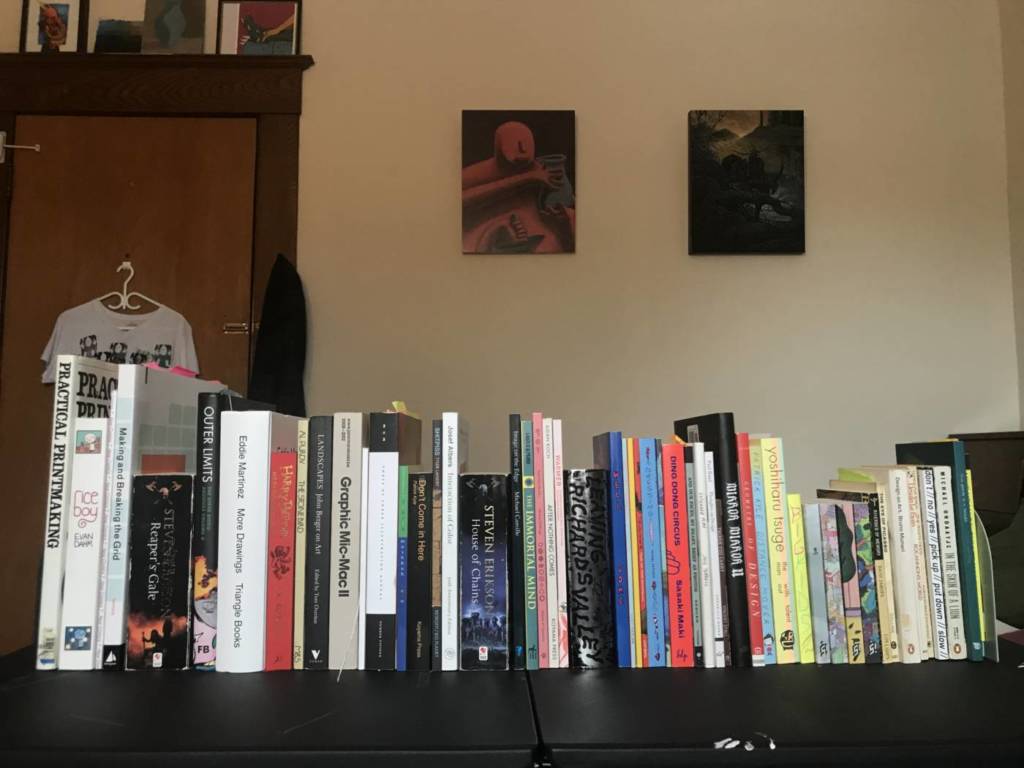


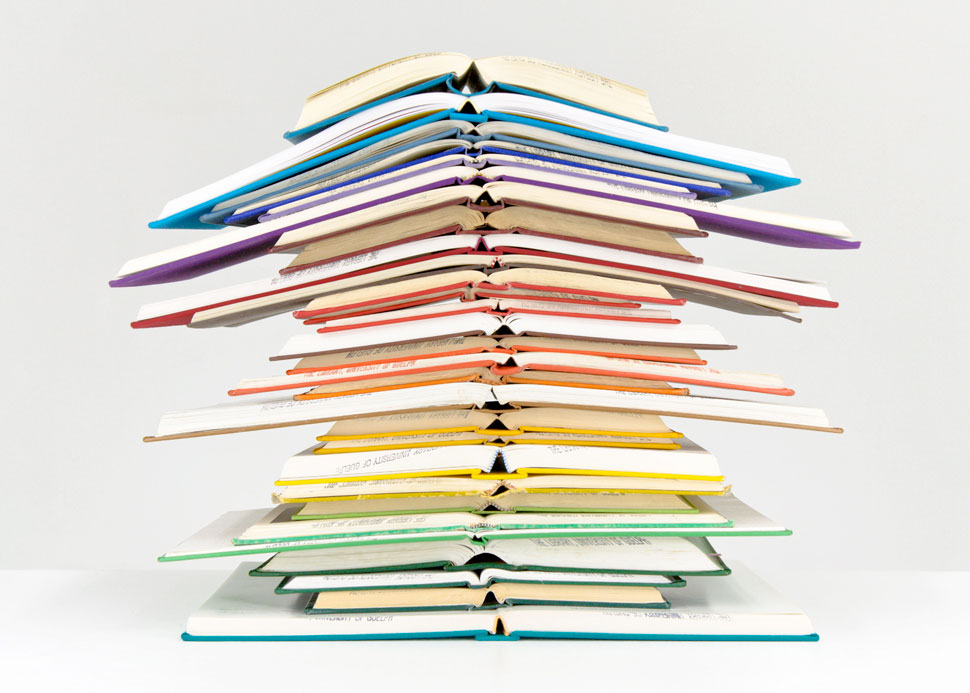
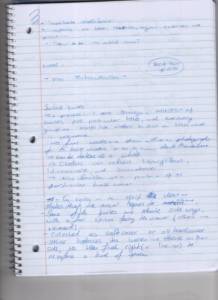
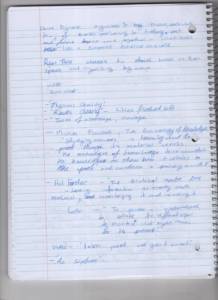

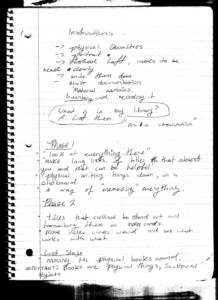
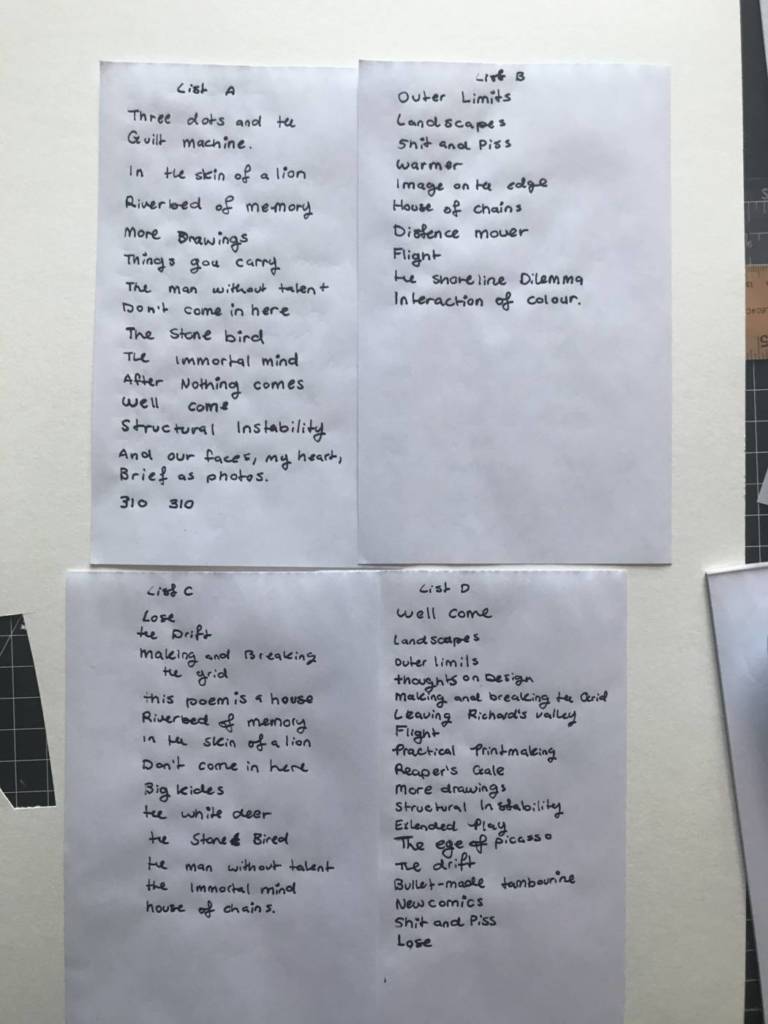
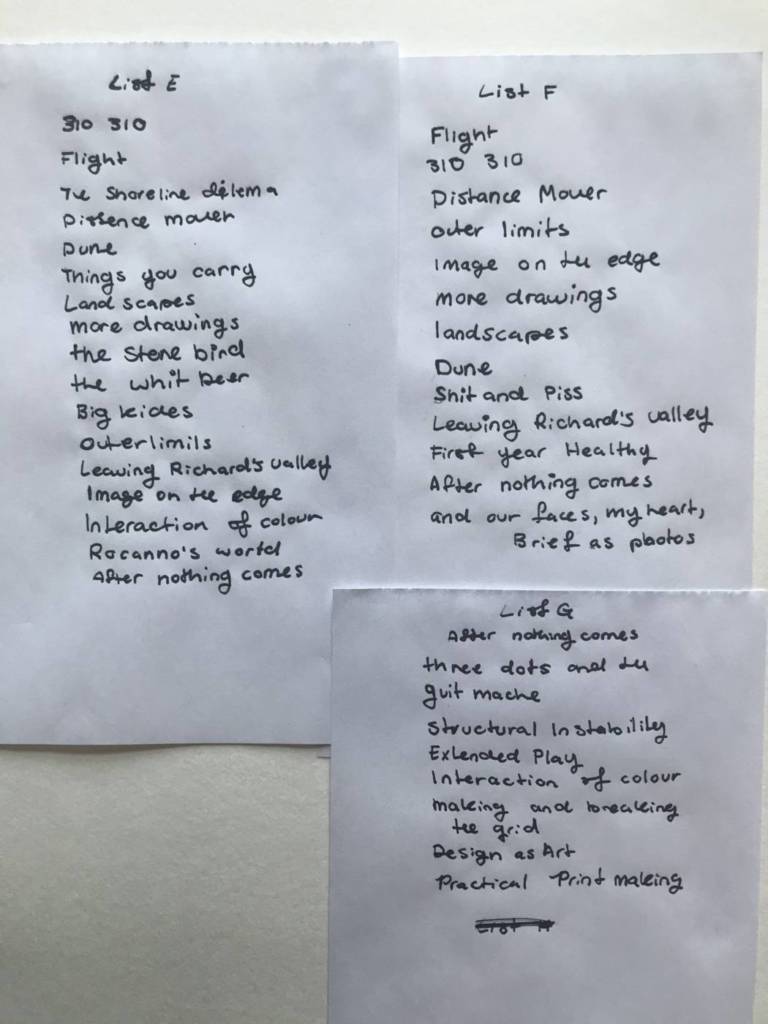
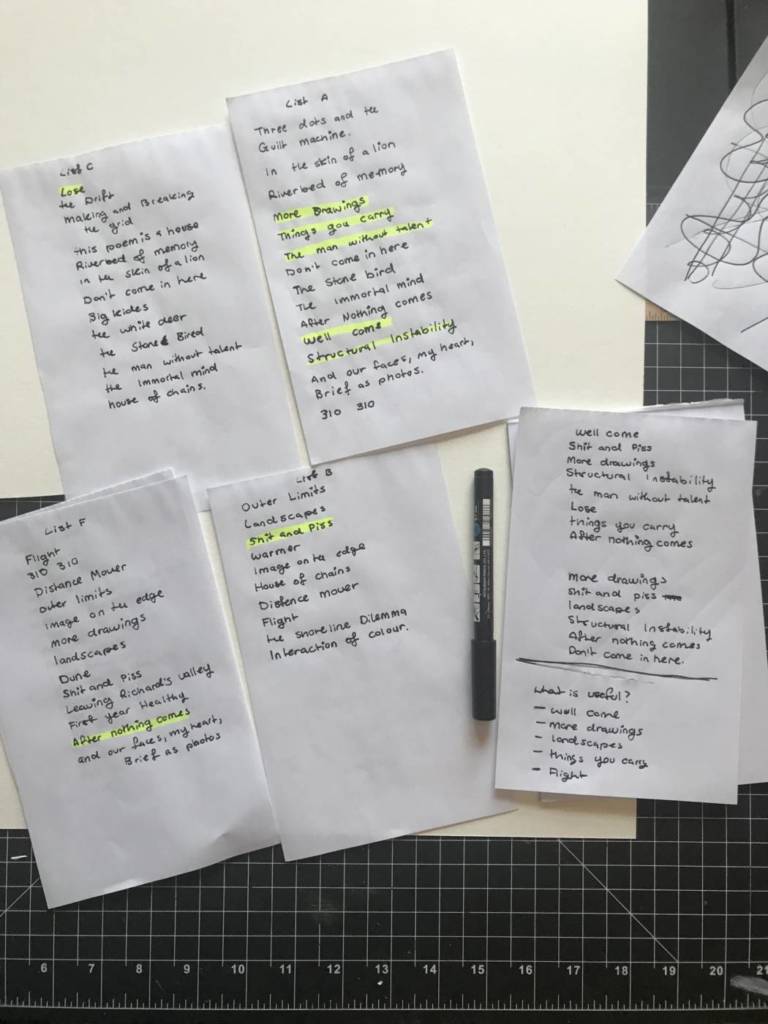

Hi Justin!
Week 1:
Katchadourian notes complete and lots of reflection and engagement, 3 Book stack images complete and more – I find them a bit puzzling (you seem to use a very personal, idiosyncratic symbology) but I see lots of thinking and processing, and a genuine investment in the materials and compositions.
Week 2:
Notes on two text works complete and epic! Sometimes you are joking I think? Is it all absurd? But shows general level of understanding of critical ideas at play.
Week 3:
Text banner exercise and description – so much process and thinking, and close consideration of the article. Great choice of found words – but your materials/colours/and context are puzzling – again – sort of a very personal symbology that isn’t available to viewers. Oh man, imagine the possibilities with “looping”! You could hang it in a circle, where it loops, or other choices that really relate to the meaning of the words. Think more about how material, form, and context all expand meaning for a wider audience – and not just a personal story.
Week 4:
Nature video- I’m wondering if this is also a bit irreverent? Or earnest? Either way is fine – but I’d love to feel one or the other more strongly, as your explicit intention. I laughed watching it – and wondered if you might stand there and be a tree as long as you can? Or showing somehow the absurdity, futility, and gap between the human and the arboreal – in some new and affecting way…and why a cellphone video in the vertical frame? No tripod/fixing of camera? Think about all these choices, especially in a subtle work like this – they all matter.
Notes – did you really dig into these pieces? A bit thin!
I know the works we look at together are surprising, and sometimes even absurd. But trust these references and give them serious attention. Art is a conversation, and you have to listen to other practitioners from the past, and now, in order to participate.
In your own work, think about experimentation (not knowing what will happen) and risk – push yourself but while being safe to make something with more complexity and seriousness.
Thank you for your attendance and engagement in class discussions and activities. We’d like to see and hear more from you!
If you would like to talk with me about your work in progress, readings, exercises, one-on-one comments on your work, and grades – send me an email in the morning to book a 15 minute appointment during the optional in person hours: Thursdays 2:30 – 4:30
And you can show up to a zoom meeting with Nathan anytime during these hours to ask your questions, and get tech support for using software and finishing your projects:
Mondays and Thursdays 1-4pm
Hi Justin,
Thanks so much for the dedicated work looking and reflecting on the readings and lecture materials, and the Yes No video worked out so well, I think you should all show it next year for Zavitz or in JAS. Thanks for your participation in class too – and contributions to all the exercises, baking, discussions etc. it’s wonderful to have you in the class and I hope we’ll see you again in Experimental 3!
Diane